by Dr. Kaylene Hughes
Introduction
The period between 31 January 1958 and 1 July 1960 was a time of outstanding success for the U.S. space program. It was also the period during which the U.S. Army made its most notable contributions to the nation's space effort. Foremost among the Army commands and installations aiding the nation's space mission was the U.S. Army Ballistic Missile Agency (ABMA). The command was located at Redstone Arsenal, Alabama, home of the Army's guided missile and rocket program. During the 30 months stretching from the successful launch of EXPLORER I to the formal transfer ceremony which officially opened the George C. Marshall Space Flight Center, the Army:
(1) placed four earth satellites into orbit;
(2) launched the Free World's first lunar probe and first solar satellite;
(3) launched three primates into space, two of which were recovered alive;
(4) initiated effort on a 1.5-million-pound- thrust booster being designed for a lunar exploration vehicle; and
(5) began work on the launch vehicle which would carry the first men into space.
The Foundation of the Army's Space Efforts
Before it accomplished these successes, however, the Army helped to lay the theoretical and technical foundations vital to the establishment of a viable space program. The ORDCIT Project, the first of the Army Ordnance Corps integrated missile projects planned to progress from test vehicle to guided missile, provided valuable information about the design and construction of missiles and rockets which had application to both the tactical weapon and space vehicle arenas. The Army's HERMES Project (under one phase of which captured German V-2 rockets were assembled and fired with the help of the German scientists who came to the United States as part of Operation Paperclip) also contributed to the Army's growing expertise in the field of missilery and rocketry.
With the addition of the BUMPER Program to the HERMES Project in 1947, in which a two-stage test vehicle was developed using the WAC CORPORAL as the second stage of a V-2, the Army began to establish distance, altitude, and velocity records which placed it in the forefront of the nation's budding space program. On 24 February 1949, a team of Army scientists under the direction of Dr. Wernher von Braun, fired BUMPER Round 5 from White Sands Proving Ground, achieving the first penetration of space by a U.S. missile.

Previously, in October 1948, the Army Chief of Ordnance had designated Redstone Arsenal, Alabama, as the center for Ordnance research and development in the field of rockets. The arsenal was officially reactivated as the site of the Ordnance Rocket Center on 1 June 1949. Later that same year, the Secretary of the Army approved the transfer of the Ordnance Research and Development Division Sub-Office (Rocket) from Fort Bliss, Texas, to Redstone Arsenal. The missile research staff headed by Dr. von Braun relocated to the arsenal in 1950. With the arrival of the Fort Bliss group, Redstone Arsenal, formerly an Ordnance munitions plant, entered the missile era. Before the end of the decade it would lead the United States into the "Space Age."
The Army's Growing Interest in Space
The Army's growing interest in space began to accelerate when the first true engineered thesis for a minimum satellite vehicle utilizing existing Army Ordnance Corps hardware was published on 15 September 1954 by the Guided Missile Development Division of the Army Ordnance Missile Laboratories at Redstone Arsenal. Written by Dr. von Braun, the thesis proposed using the REDSTONE missile as the main booster of a four-stage rocket for launching artificial satellites. The three upper stages were to consist of LOKI rockets. The plan was later expanded into a joint Army-Navy proposal called Project ORBITER. However, the Army's official role in the U.S. space satellite program was delayed after higher authorities elected in 1955 to pursue Project VANGUARD, which was based on the Navy's VIKING missile.
The essential organizational elements and personnel responsible for the Army's spectacular accomplishments in space came together on 1 February 1956 with the activation of ABMA at Redstone Arsenal. Although the new agency began its existence with a purely military mission, it would be known and remembered best for its accomplishments in space. As early as April 1956, the Army advised the Department of Defense (DOD) that the JUPITER C missile could orbit a satellite by the end of the calendar year as an alternate to VANGUARD. In May 1956, however, DOD informed the Army that it was not to initiate any plans or preparations for using any part of the JUPITER or REDSTONE programs as the basis for an orbital launch vehicle.
Early Army Successes
As part of its reentry test vehicle program, the Army flight tested a staged missile on 20 September 1956 that could have orbited the world's first satellite. JUPITER C RS-27 flew 3,355 miles; attained an altitude of 682 miles; and achieved a velocity of Mach 18, enough to have put its fourth stage into orbit if permission had been granted to do so. Having proved that it had the necessary capability, the Army continued to offer ABMA's potential to launch a satellite as a backup to the VANGUARD program, but again it was ordered to refrain from any efforts in this area. Not until the Soviet Union had successfully launched two Earth satellites--SPUTNIK I and SPUTNIK II--in October and November 1957, respectively, did the Secretary of Defense lift the restrictions which had been placed on the Army's participation in the U.S. space satellite program.
Launch of JUPITER C RS-27
Four months before it was ordered to prepare a JUPITER C to launch a U.S. satellite, the Army team at Redstone Arsenal resolved the nose cone reentry heat problem. The nose cone from the flight test of JUPITER C RS-40 was recovered intact on 8 August 1957, marking the first time that a man-made object had been retrieved from outer space as well as proving the suitability of the nose cone's ablative-type heat protection. It also carried the first missile mail ever delivered over intermediate range ballistic missile (IRBM) distance. In a major televised address on science and security on 7 November 1957, President Dwight D. Eisenhower announced that Army scientists had successfully solved the problem of ballistic missile reentry. The nose cone recovered on 8 August was shown to the nation during this telecast.
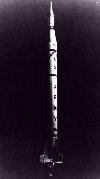

Earth Satellites and Space Probes
With the successful launch of EXPLORER I on 31 January 1958, just 84 days after receiving the mission, the Army embarked on an ambitious program which rapidly advanced U.S. interests and goals in the space arena. The Army Ballistic Missile Agency, which became a subordinate element of the Army Ordnance Missile Command (AOMC) on 31 March 1958, placed additional EXPLORER satellites into orbit on 26 March 1958, 26 July 1958, and 13 October 1959. Also, on 27 March 1958, the Secretary of Defense assigned ABMA responsibility for launching two lunar probes.

Preparing EXPLORER I for launch
The first of these--PIONEER III--was launched on 6 December 1958 and went 66,654 miles toward the Moon before dropping back to earth after 38 hours of flight. Although a failure as a lunar probe, PIONEER III was considered a scientific success because of the data it provided on cosmic radiation. It also was a successful test of the four-stage JUNO II launch vehicle. On 3 March 1959, PIONEER IV, a joint ABMA/Jet Propulsion Laboratory (JPL) project under the direction of the National Aeronautics and Space Administration (NASA), achieved a velocity in excess of 24,560 miles per hour; passed within approximately 36,000 miles of the Moon; and traveled on to become the first U.S. satellite in permanent orbit around the Sun.
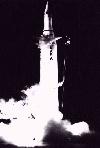
Lift-off of PIONEER IV
The SATURN Booster Project
As part of a long-range project for lunar exploration, ABMA was ordered to begin work in August 1958 on a 1.5-million-pound-thrust booster for the multistage launch vehicle program later named SATURN. The project was initially authorized and funded by the Advanced Research Projects Agency (ARPA). Army personnel located at Redstone Arsenal worked on this project until AOMC lost all of its space missions to NASA in July 1960.

SATURN Static Test Tower
The Monkey Flights
Between 13 December 1958 and 5 May 1961, the Army also made several outstanding contributions toward putting a man into space. The Army launched JUPITER AM-13 on 13 December 1958 which carried a squirrel monkey named Gordo over IRBM distance. This flight provided highly useful data for Army and Navy medical research into manned space flights. Although Gordo made the flight with no known adverse effects, the monkey could not be recovered because the nose cone's float mechanism failed.
On 28 May 1959, the flight of monkeys Able and Baker marked the first successful recovery of living beings after their return to earth from outer space. The monkeys rode in the nose cone of JUPITER Missile AM-18 to an altitude of 300 miles and a distance of 1,500 miles, successfully withstanding 38 times the normal pull of gravity and a weightless period of about 9 minutes. Their survival of speeds over 10,000 miles per hour was the first step toward putting a man into space.
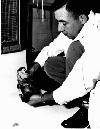
Monkey Gordo |
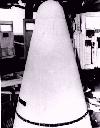
Nose cone containing Gordo shortly before launch |

JUPITER Missile AM-18 containing monkeys Able and Baker |

Successful recovery of monkeys Able and Baker |
The MERCURY-REDSTONE Program
Shortly after its first official day on 1 October 1958, NASA formally organized a project to place a manned space capsule in orbit. This program was officially named Project MERCURY on 26 November 1958. Army REDSTONE missiles were modified for use in NASA's test vehicle program. On 19 December 1960, a MERCURY-REDSTONE missile (MR-1A) successfully carried a 1-ton MERCURY capsule 135 miles high and 235 miles downrange of the Atlantic Missile Range, Cape Canaveral, Florida.
The successful suborbital flight of MERCURY-REDSTONE 2 carried a chimpanzee named Ham, helping to prove the system's operational capabilities in a space environment. Ham survived the mission safely. The first manned space flight was accomplished on 5 May 1961 when CDR Alan B. Shepard, Jr., a Navy astronaut, rode a MERCURY-REDSTONE (MR-3) on a suborbital flight. The last MERCURY-REDSTONE mission, also a manned suborbital flight, carried CPT Virgil I. Grissom, an Air Force astronaut, to a peak altitude of 118 miles and safely landed him 303 miles downrange.
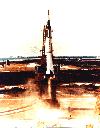
First manned space flight
The End of the Army's Role in Space
After the creation of NASA in July 1958, most of the Army's efforts in the space arena gradually began to fall under the direction of the new civilian agency. In December 1958, the functions and facilities of JPL, which had been part of the Army since 1945, were transferred to NASA after the agency requested in October 1958 that both JPL and ABMA's space activities be transferred to its jurisdiction. A year after this initial request, presidential approval was given for the transfer of ABMA scientists and engineers to NASA.
Previously, on 3 December 1958, the Army and NASA had reached an agreement whereby AOMC and its subordinate organizations at Redstone Arsenal would be responsive to NASA requirements. After it was decided on 20 October 1959 to transfer the Army's space mission to NASA, the Army's work for the civilian agency continued under the agreement of December 1958. Technical direction of the SATURN booster program was transitioned from the Army to NASA in November 1959 pending the official transfer on 15 March 1960.
On 1 July 1960, AOMC formally lost all of its space-related missions, along with about 4,000 civilian employees (including the Von Braun team) and $100 million worth of buildings and equipment at Redstone Arsenal and Cape Canaveral. Prior to the transfer, AOMC's mission had been changed to eliminate the projects being transitioned to NASA as well as all references to spatial missiles and vehicles.
The activation of NASA's George C. Marshall Space Flight Center at Redstone Arsenal on 1 July 1960 marked the end of the Army's pioneering efforts in outer space. Although the Army's "Old Reliable" REDSTONE missile continued to be used in NASA's MERCURY-REDSTONE program, the Army no longer had the kind of active leadership role that had characterized its endeavors in the early years of the nation's space program. During that early period, the Army organizations at Redstone Arsenal helped to establish the predominance of the United States in the exploration of space. Not long after his transfer to Washington, D.C., in 1970, Dr. Wernher von Braun recounted the Army's contributions:
Please let me emphasize that without the continuous and great help of the U.S. Army elements at Redstone-- and their highly capable and versatile personnel--the Marshall Center and our national space program would not be where they are today...I am happy to once again express my deep appreciation for the many substantial opportunities that the U.S. Army has afforded me during my long years of association with it and its splendid members.

Army-NASA transfer ceremony
